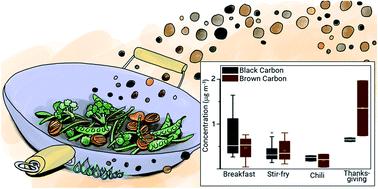当前位置:
X-MOL 学术
›
Environ. Sci.: Processes Impacts
›
论文详情
Our official English website, www.x-mol.net, welcomes your feedback! (Note: you will need to create a separate account there.)
Indoor black carbon and brown carbon concentrations from cooking and outdoor penetration: insights from the HOMEChem study
Environmental Science: Processes & Impacts ( IF 5.5 ) Pub Date : 2021-09-10 , DOI: 10.1039/d1em00283j Sumit Sankhyan 1 , Sameer Patel 1 , Erin F Katz 2, 3 , Peter F DeCarlo 4 , Delphine K Farmer 5 , William W Nazaroff 6 , Marina E Vance 1
Environmental Science: Processes & Impacts ( IF 5.5 ) Pub Date : 2021-09-10 , DOI: 10.1039/d1em00283j Sumit Sankhyan 1 , Sameer Patel 1 , Erin F Katz 2, 3 , Peter F DeCarlo 4 , Delphine K Farmer 5 , William W Nazaroff 6 , Marina E Vance 1
Affiliation

|
Particle emissions from cooking are a major contributor to residential indoor air pollution and could also contribute to ambient concentrations. An important constituent of these emissions is light-absorbing carbon, including black carbon (BC) and brown carbon (BrC). This work characterizes the contributions of indoor and outdoor sources of BC and BrC to the indoor environment by concurrently measuring real-time concentrations of these air pollutants indoors and outdoors during the month-long HOMEChem study. The median indoor-to-outdoor ratios of BC and BrC during the periods of no activity inside the test house were 0.6 and 0.7, respectively. The absorption Ångström exponent was used to characterize light-absorbing particle emissions during different activities and ranged from 1.1 to 2.7 throughout the campaign, with the highest value (indicative of BrC-dominated emissions) observed during the preparation of a simulated Thanksgiving Day holiday style meal. An indoor BC exposure assessment shows that exposure for an occupant present in the kitchen area was ∼4 times higher during Thanksgiving Day experiments (primarily due to candle burning) when compared to the background conditions.
中文翻译:

来自烹饪和室外渗透的室内黑碳和褐碳浓度:来自 HOMEChem 研究的见解
烹饪产生的颗粒排放是造成住宅室内空气污染的主要因素,也可能导致环境浓度升高。这些排放物的一个重要组成部分是吸光碳,包括黑碳 (BC) 和棕碳 (BrC)。这项工作通过在为期一个月的 HOMEChem 研究期间同时测量室内和室外这些空气污染物的实时浓度来表征 BC 和 BrC 的室内和室外来源对室内环境的贡献。在测试室内没有活动期间,BC 和 BrC 的室内外比率中位数分别为 0.6 和 0.7。吸收 Ångström 指数用于表征不同活动期间吸光粒子的发射,在整个活动期间范围从 1.1 到 2.7,在准备模拟感恩节假日风格的膳食期间观察到的最高值(指示以 BrC 为主的排放量)。室内 BC 暴露评估表明,与背景条件相比,在感恩节实验期间(主要是由于蜡烛燃烧),厨房区域内居住者的暴露程度高出约 4 倍。
更新日期:2021-09-15
中文翻译:

来自烹饪和室外渗透的室内黑碳和褐碳浓度:来自 HOMEChem 研究的见解
烹饪产生的颗粒排放是造成住宅室内空气污染的主要因素,也可能导致环境浓度升高。这些排放物的一个重要组成部分是吸光碳,包括黑碳 (BC) 和棕碳 (BrC)。这项工作通过在为期一个月的 HOMEChem 研究期间同时测量室内和室外这些空气污染物的实时浓度来表征 BC 和 BrC 的室内和室外来源对室内环境的贡献。在测试室内没有活动期间,BC 和 BrC 的室内外比率中位数分别为 0.6 和 0.7。吸收 Ångström 指数用于表征不同活动期间吸光粒子的发射,在整个活动期间范围从 1.1 到 2.7,在准备模拟感恩节假日风格的膳食期间观察到的最高值(指示以 BrC 为主的排放量)。室内 BC 暴露评估表明,与背景条件相比,在感恩节实验期间(主要是由于蜡烛燃烧),厨房区域内居住者的暴露程度高出约 4 倍。


























 京公网安备 11010802027423号
京公网安备 11010802027423号